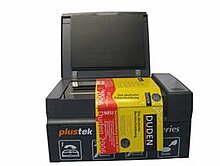Book scanner


A book scanner is a special scanner , which for the digitization of books is optimized. In practice, this scanner is combined with special software that saves the digital copies in the desired form.
application
With the book scanner, bound documents (books, journals, magazines) are scanned in a gentle way without exposing them to excessive stress. Since pages are constantly turned during this process, this must be done as gently and efficiently as possible.
Book scanners are used wherever a large number of books have to be digitized. They are preferably used in archives, libraries, law firms and insurance companies. The result of a scanning process is a digital image file as digitized is referred to. Depending on the requirements, the digitized version comprises one page or the entire work.
Executions
Book scanners can be divided into three categories:
- manual book scanner
- Reflected light scanner
- adapted flatbed scanner
- semi-automatic
- fully automatic book scanners (often also scan robots )
Manual book scanners are particularly suitable as add-on devices for the quick scan of books and magazines, as is necessary for insurance companies, law firms or authorities. In contrast to the automatic scanning robots, more compact book scanners are an efficient alternative here. Books can be conveniently placed on the platen glass and scanned without distortion or book fold shadows. The semiautomatic or fully automatic scanning robots, with which entire book collections and magazine archives can be digitized as quickly as possible, are suitable for larger scanning volumes. On the other hand, there is a connection that the more comfortable scanning is for books and editors, the higher the price of the device. Manual book scanners are used more in small law firms (with a smaller scan volume) and scan robots in large archives (for huge data stocks).
Book cradle and book holder

In contrast to conventional copiers or flatbed scanners , the book no longer lies with its sides down on a glass plate. This position and the additional weight caused by the cover put too much strain on the spine of the book. When scanning, the book must be with the open pages facing up - the book cradle offers the best conditions for this . It consists of two height-adjustable plates, on which the book is arranged so that the pages are as flat as possible. The surface of the sides can be smoothed by pressing a glass plate. Book cradles can be moved manually or with the help of an electric motor, depending on the design.
If the book cannot be opened completely, for example to protect the cover , book cradles are used as special book holders. These consist of an angled shelf for the book. Often an additional glass plate ensures a flat surface. With some book holders, the image is guided to the camera or the scanning head via a mirror, as is the case with the Wolfenbüttel book mirror .
Google is pursuing a completely new approach with an automatic scanner in which the book is placed from above on a wedge-shaped rail, which is scanned from the inside through slots, and where the page is also turned through slots in the rail.
Scanning historical books
More and more libraries, museums and archives are digitizing their holdings in order to make them accessible to a broad public. The scanning of historical book stocks, however, places high demands on the devices. Books that are hundreds of years old often have a restricted opening angle. Book supports that require an opening angle of 180 ° would damage the stitching, binding material, spine and joints of many prints. Even opening angles between 110 ° and 90 ° for one-sided recordings can be problematic with such books. To avoid damaging the books, use a V-shaped book cradle or book cradle. This allows the opening angle to be reduced by up to 45 °, as with the Wolfenbüttel book mirror.
software
The scan software significantly influences the scan speed and the usability of the digitized material . In addition to simply scanning the page, automatic text recognition is often carried out. Additional functions such as automatic rotating and trimming of pages or automatic compensation of the curvature of the side improve the quality of the end product.
Page turning process
While the pages of manual book scanners are turned by hand, fully automatic devices have different mechanisms.
ScanRobot
A prototype of a ScanRobot was developed by the Austrian company Treventus and won the Grand Price of the European Information and Communication Technology Award at Cebit 2007 .
In the case of older documents in particular, the device must work gently, which is achieved by means of special paging devices with the aid of suction pumps. Through this, a ScanRobot can go through bound documents fully automatically and works more gently than manual page turning.
Web links
Individual evidence
- ↑ Linear Book Scanner (November 12, 2012, Google Tech Talk, Youtube film)
- ↑ Conrad Gruber: No more turning the pages - Treventus: Success story with ScanRobot . On: MONITOR online. June 2006



